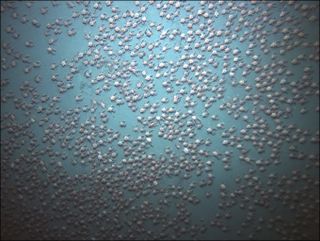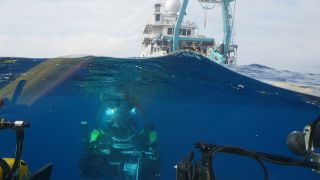Red Crabs Swarm Like Insects in Incredible Underwater Video

A strange cloud of disturbed silt in the Pacific Ocean off the coast of Panama unexpectedly led marine biologists to an incredible sight: thousands of red crabs close to the sea bottom that were "swarming like insects," according to the researchers.
The scientists were in a submersible investigating biodiversity at the Hannibal Bank seamount — an underwater mountain and a known ecological hotspot — when they spotted a disturbance in the water that led them to the unusual sight at depths of 1,165 feet to 1,263 feet (355 to 385 meters).
A teeming mass of crabs seethed on the seamount's northwestern flank, with the highest density measured at 78 crabs in a single square meter (about seven crabs per square foot). [Video: Watch Swarms of Red Crabs on Hannibal Seamount]
DNA analysis later identified the species as red crabs (Pleuroncodes planipes). These colorful swimming crustaceans are reddish orange and resemble miniature lobsters, with the adult carapace, or hard outer shell, measuring up to 1.3 inches (3.3 centimeters) in length.
Red crabs are usually found in Baja California waters, off the northwest coast of Mexico. However, they can be abundant off the coasts of southern and central California during El Niño events, when western Pacific waters are warmer than average.
But they had never been documented this far south, according to the study's lead author, Jesús Pineda, a biologist at Woods Hole Oceanographic Institution (WHOI) and chief scientist on the research cruise.
"To find a species at the extreme of their range, and to be so abundant, is very unusual," Pineda said in a statement. Pineda suggested that the crabs, which are typically found in shallower waters, might have congregated at oxygen-poor depths to steer clear of predators.
Sign up for the Live Science daily newsletter now
Get the world’s most fascinating discoveries delivered straight to your inbox.

Scientists found and documented the swarming crabs in April 2015. Later in the year, a mass stranding of red crabs was reported on a San Diego beach, and genetic sampling confirmed that they were the same species as the crabs viewed at Hannibal Bank. This suggests that the species' usual range may extend farther south than previously suspected, the researchers reported in the study.
While seamounts are known to host a high level of biodiversity, little is known about the processes shaping the wildlife populations that inhabit them. Unexpected sightings like this red crab swarm highlight how much there is yet to detect about how animals in these communities behave, and may inform future studies investigating interactions among species, researchers say.
The findings were published online today (April 12) in the journal PeerJ.
Follow Mindy Weisberger on Twitter and Google+. Follow us @livescience, Facebook & Google+. Original article on Live Science.

Mindy Weisberger is an editor at Scholastic and a former Live Science channel editor and senior writer. She has reported on general science, covering climate change, paleontology, biology and space. Mindy studied film at Columbia University; prior to Live Science she produced, wrote and directed media for the American Museum of Natural History in New York City. Her videos about dinosaurs, astrophysics, biodiversity and evolution appear in museums and science centers worldwide, earning awards such as the CINE Golden Eagle and the Communicator Award of Excellence. Her writing has also appeared in Scientific American, The Washington Post and How It Works Magazine. Her book "Rise of the Zombie Bugs: The Surprising Science of Parasitic Mind Control" will be published in spring 2025 by Johns Hopkins University Press.